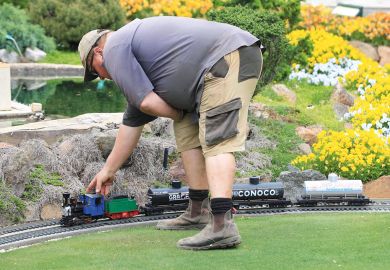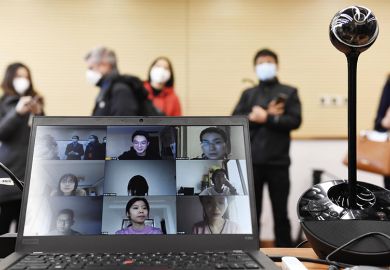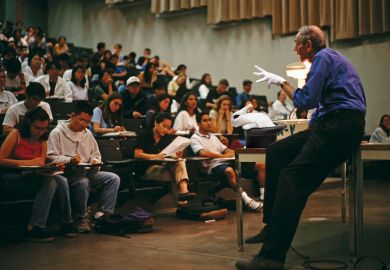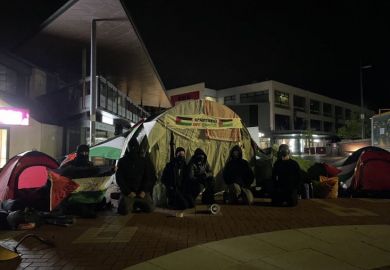Browse the full results of the World University Rankings 2024
As we reconstruct the university experience after the Covid pandemic, the question of how we get students to return to campus is increasingly asked. The current generation of university students has experienced fragmented in-person education, disrupted by lockdowns and border closures, in addition to increased financial pressures that require working extended hours. The combination of becoming accustomed to the convenience of online learning and being unfamiliar with the benefits of campus-based study, as well as cost-of-living pressures, means student attendance can no longer be taken for granted.
Fundamental to supporting students to return to campus are rich, engaging educational offerings on campus, and this has been written about extensively. There are, however, some other factors worth exploring.
The first is that there is a binary nature to some of the discussion that deserves to be challenged. Students are said to be either on campus or learning remotely. Study is either in person or it is online. Yet the post-Covid world is more complex and interesting than these binaries suggest.
Those who study predominantly online might still benefit from short periods of intense in-person study (for example at the start of a degree or for a capstone). The Australian government recently announced A$67 million (£35 million) to extend a network of Regional University Centres to additional underserved areas. These regional study hubs allow those studying online at a variety of universities to access reliable internet, support and a cohort of peers, which has been shown to increase participation and retention in areas with low university enrolment.
Likewise, those studying predominantly face to face will still expect to do so in a digitally rich environment. Pharmacy students at Griffith University, for example, spend part of their on-campus time in a highly sophisticated virtual environment that teaches them modern pharmaceutical practices. They engage in a three-week competition that involves them running their own virtual pharmacies in small groups, competing against one another and students from Malaysia. This type of learning experience draws on the best of both physical and digital learning and prepares students for workplaces where they will need to be able to move seamlessly between these two worlds.
In-person education is also no longer solely campus-based; important learning experiences take place in a wide variety of settings. Such experiences, of course, include the clinical placements and internships that are now a key part of most degrees, as well as international study. Yet they extend beyond these.
At Griffith, in addition to attending classes on campus, students are working on joint projects in a start-up lab in an innovation precinct, on boats protecting the marine environment, in an outback region assisting with increasing tourism, and around the city and beyond developing major public artworks and supporting a regional film festival. As well as developing their understanding of course content, such experiences create a strong sense of cohesion between participants and allow them to demonstrate their skills in real-world settings.
In other cases, the boundaries between the campus and workplaces are becoming more permeable. Earlier this year, the Griffith University musical theatre programme moved into its new home in the Queensland Performing Arts Centre. The students learn in studios that back on to working theatres; they socialise in the same spaces as professional performers and crew; and now nearly half of the cohort have roles working in front-of-house jobs. They are a few minutes’ walk from the Queensland Conservatorium, with a fuller range of university campus facilities; for most purposes, however, their classrooms and their current (and potentially future) workplace are in the same facility. Such opportunities certainly create an enthusiasm and motivation for coming to “campus” regularly.
So the landscape is far more complex than simply on campus or online, and student learning is all the better for it. Yet on-campus learning remains a critical element of most students’ education. It has undoubtedly come under pressure from students who through choice or circumstance are either not attending at all or are attending for only short periods.
This is an appropriate time to consider the whole infrastructure of opportunities that make coming to physical campuses worthwhile, beyond the quality of in-person teaching.
Such initiatives must recognise the circumstances in which many students find themselves – sometimes with a long commute to campuses, trying to undertake substantial paid work, possibly juggling carer commitments, and struggling with the cost of living. Having the right support services on campus – from reasonably priced food and childcare to medical and psychological care – can be an incentive to come to campus and can make the cost of study easier. As the Australian government seeks through the Universities Accord process to increase participation of students from low socio-economic backgrounds, it will be important to recognise that students in need will require better access to such facilities, in addition to scholarships and educational support.
There are also actions that universities can take without additional funding. Tackling the complex issue of timetabling to try to create a consistent couple of days a week that students have their study scheduled can both create time for industry experiences or paid work and make it more worthwhile for students to undertake travel. Working with public transport authorities to better support students in travelling to campus is another small, practical step that can assist those based off-campus.
Finally, working with student clubs and societies to create an ecosystem of experiences is critical to building a sense of belonging. Lockdowns had a serious impact on many student clubs, whose current generation of leaders have little experience of how to hold events in person and whose membership has often dropped. This is a sensible time for universities to support those student groups that can make all the difference to students feeling a sense of belonging and give them a reason to attend campus even when classes might be feeling dry or difficult.
Returning students to in-person learning will not be a simple or quick endeavour. Creating high-quality experiences both on and beyond campus, making campuses places of care for students who are struggling, and empowering students to create opportunities for one another are important steps in this journey.
Carolyn Evans is vice-chancellor and president of Griffith University. She will be speaking on a panel about the value proposition of the on-campus experience at Times Higher Education’s World Academic Summit in Sydney, from 26 to 28 September. Register to attend.
Register to continue
Why register?
- Registration is free and only takes a moment
- Once registered, you can read 3 articles a month
- Sign up for our newsletter
Subscribe
Or subscribe for unlimited access to:
- Unlimited access to news, views, insights & reviews
- Digital editions
- Digital access to THE’s university and college rankings analysis
Already registered or a current subscriber? Login










